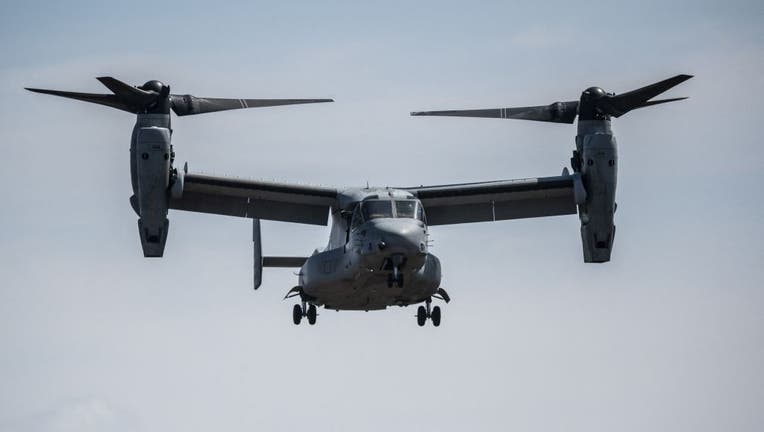4 US Marines identified in deadly NATO drill crash

A US Marine Corps MV-22 Osprey tilt-rotor aircraft lands during a joint exercise with Japanese Self Defense Forces members at the Higashifuji training area in Gotemba, Shizuoka Prefecture on March 15, 2022. (Photo by Charly TRIBALLEAU / AFP) (Photo b
HELSINKI (AP) - The U.S. Marine Corps has identified the four Marines who died when their Osprey aircraft crashed Friday night in a Norwegian town in the Arctic Circle during a NATO exercise.
The men, all assigned to Marine Medium Tiltrotor Squadron 261, Marine Aircraft Group 26, 2d Marine Aircraft Wing stationed on Marine Corps Air Station New River, North Carolina, were identified as:
— Capt. Matthew J. Tomkiewicz, 27, of Fort Wayne, Indiana.
— Capt. Ross A. Reynolds, 27, of Leominster, Massachusetts.
— Gunnery Sgt. James W. Speedy, 30, of Cambridge, Ohio.
— Cpl. Jacob M. Moore, 24, of Catlettsburg, Kentucky.
In a statement issued Sunday night, a Marine Corps spokesman said the bodies were removed from the crash site and were in the process of being returned to the U.S.
RELATED: West Point cadets on spring break overdose on fentanyl-laced cocaine in South Florida vacation home
The cause of the crash remained under investigation, but Norwegian police reported bad weather in the area.
Officials in Norway said the MV-22B Osprey crashed in Graetaedalen in Beiarn, south of Bodoe.
The Marines, assigned to 2nd Marine Aircraft Wing, II Marine Expeditionary Force, were taking part in a NATO exercise called Cold Response.
The aircraft was an MV-22B Osprey. It "had a crew of four and was out on a training mission in Nordland County" in northern Norway, the country's armed forces said in a statement.

As the Russian invasion into Ukraine is in its second week, Vice President Kamala Harris held a joint news conference with Polish President Andrzej Duda while on a European tour to meet with NATO allies. Reporters confronted both leaders after the Biden administration rejected a proposal from Poland that would have made its old Russian-made MiG fighters available to a U.S. base in Germany for potential handover to Ukraine.
It was on its way north to Bodoe, where it was scheduled to land just before 6 p.m. Friday. The Osprey crashed in Graetaedalen in Beiarn, south of Bodoe. Police said a search and rescue mission was launched immediately. At 1:30 a.m. Saturday, the police arrived at the scene and confirmed that the crew of four had died.
The Cold Response drill includes around 30,000 troops, 220 aircraft and 50 vessels from 27 countries. Non-NATO members Finland and Sweden are also participating. The exercises began on March 14 and end on April 1.
RELATED: Army develops high-tech solution to keep hands warm without gloves
No cause was given for the crash, but the Norwegian armed forces said that Cold Response "will carry on as planned, with the measures we have to take due to the weather."
A Norwegian rescue helicopter spotted the crash site late Friday and local Red Cross crews were assigned to assist police on the ground, Norwegian media said.
Norwegian newspaper VG said Red Cross members drove close to the crash site with scooters and marked the trail with GPS for police in what they described as extremely difficult weather conditions early Saturday.
"It was a special night, it was a real storm. There were five of us driving towards the scene of the accident. There was one meter of visibility, snow and storm in the mountains, " Red Cross team leader Oerjan Kristensen told VG. "I guess it was a wind gust of 30-40 meters per second. When it blows like that, it is difficult to stand upright."
Kristensen added that the rescue operation is being hampered by the risk of landslides in the mountains, and the remoteness of the crash site.
Police launched an investigation into the crash and accident commission members and police representatives were due to arrive at the crash site on Saturday.
"The weather is very bad in the area to complete work at the scene, but police will take it up again as soon as the weather conditions allow it," operations manager Ivar Bo Nilsson from the Norland police district told reporters.
Lt. Gen. Yngve Odlo, head of the Norwegian Armed Forces’ operational headquarters, said that Cold Response would continue despite the crash.
"Right now there is full focus on ending the rescue operation, taking care of the people and then there will be a normal procedure with causation," Odlo was quoted as saying by Norwegian public broadcaster NRK.
The first Cold Response exercise was held in 2006, and the drills are conducted every two years. They take place in southeastern, central and northern Norway.

